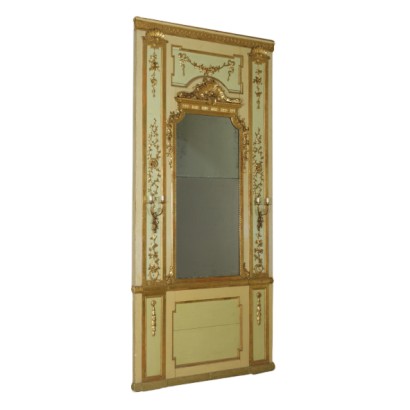The end of the room
Features
Style: Neo-Classical (1765-1790)
Age: 18th Century / 1701 - 1800
Year: Ultimo quarto del XVIII sec.
Origin: Lombardia, Italy
Main essence: Silver Fir
Description
Great end of the room from the Palace. A high plinth, marked by the frame of separation, and acts as a support for a large mirror containing two panes of blown glass with silver stretched out on the mercury. The mirror is completed by a frontispiece of carved, classical motifs, resting on which is a conch shell with two wreaths of laurel leaves held in place by a tape with the surface, while from the Greek that end of the gable fall for the elegant branches of flowers; in a reserve upper two straps with festoon of flowers are held by two galls. To the sides of the mirror two large pilasters contain the reasons for the neo-classical, typical of the period, rosettes, and festoons, branches of oak, maple, myrtle, and at the centre there are two wall sconce in wrought iron, in the manner of ribbons and leaves, with two lamps each. A frame of can-current ends of the bottom-room. The furniture is lacquered in shades of green with gilded carvings gouache.
Product Condition:
Product in good condition, has small signs of wear and tear.
Dimensions (cm):
Height: 335
Width: 165
Depth: 18
Certificate issued by: Enrico Sala
Additional Information
Style: Neo-Classical (1765-1790)
This historical period includes a first phase that can be properly defined as the Louis XVI style.nOnly at a later time, with the maturation of archaeological fashions, was a new vision of furnishing civilization formulated and codified, now fully attributable to the Neoclassical Style.
In fact, both trends coexisted in unison until the last years of the eighteenth century.
nIn the field of cabinet making, the Directoire, Retour d'Egypte, Consular and Empire styles also fall within the neoclassical era.
nFind out more about Neoclassicism with the insights from our blog...
n































